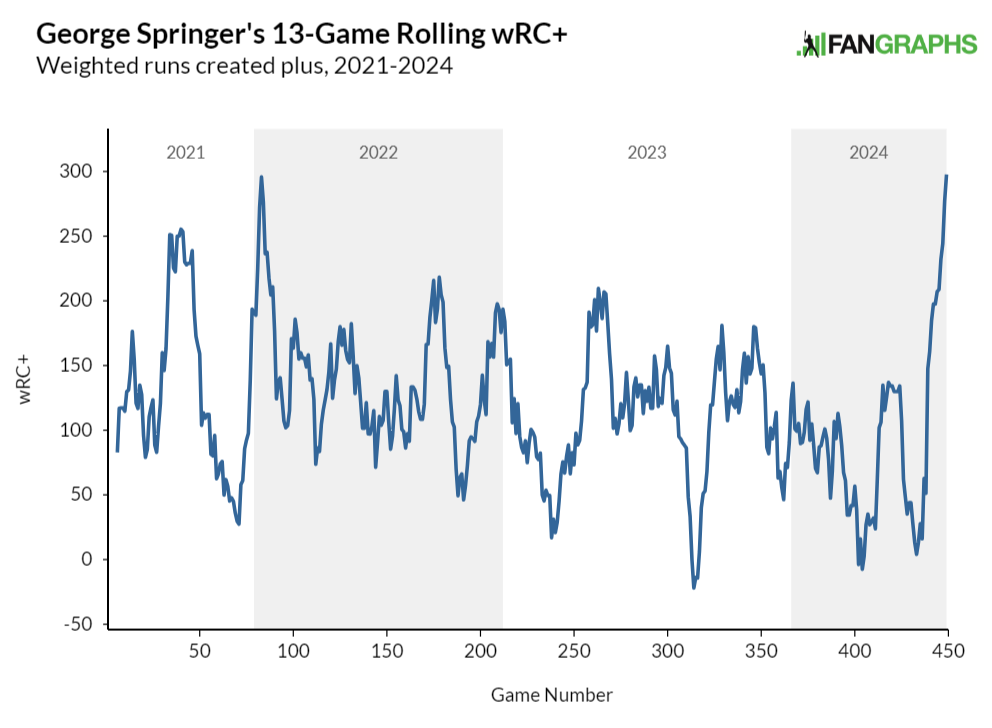
Just two weeks ago, the story of George Springer’s 2024 season looked like it would be a dreary tale.
Many Toronto Blue Jays fans were wondering if the veteran had anything left and questioning why he was hitting so high in the order at a time when one of the best leadoff men of his era was usually hitting fifth, sixth, or seventh.
That wasn’t pure alarmism or residual negativity from a disappointing season for the Blue Jays. When a 34-year-old player coming off the worst offensive season of his career is slashing .188/.278/.281 in late June — as Springer was two Monday mornings ago — it’s valid to wonder if he’s hit a wall.
If the last 13 games the outfielder has played are any indication, that simply isn’t the case. In that span, Springer has hit .425/.511/.875. That’s not just a little regression to the mean, it’s an eye-opening heater.
Not only has Springer been the best position player in the majors since June 25 by fWAR, he’s also just authored the most productive 13-game stretch of his Blue Jays career by wRC+.
While any hitter is capable of having themselves an impressive fortnight, this performance is a cut above your average hot streak. It’s also consequential coming off 70-plus games of offensive ineptitude.
The question for the Blue Jays — who have Springer under contract through 2026 — is whether what they are seeing from the outfielder now is an indication of what’s to come. The 34-year-old won’t be able to slug over .800 forever, but it seems there’s far more life in his bat than it’s appeared for most of the season.
When it comes to drawing meaning from small samples, the most obvious place to look is strikeout and walk rates. Sometimes, hitters make meaningful changes to their approaches, and that shows up quickly in those statistics. Vladimir Guerrero Jr.’s increased aggression recently is a good example of that.
In Springer’s case, swing decisions do not appear to be at the root of his newfound success. He has strong walk (12.5 per cent) and strikeout rates (20.8 per cent) during his current hot streak, but those numbers (10.8 per cent and 17.6 per cent, respectively) were both excellent in his first 71 games of the season.
Springer’s biggest issue for most of 2024 hasn’t been plate discipline or an inability to make contact. The problem has been that when his bat meets the ball the results have been unimpressive.
In his first 295 plate appearances of the season, Springer put the ball in play 210 times and had just 12 barrels and 14 extra-base hits to show for his efforts. His average exit velocity (86.5 m.p.h.) was also well below MLB average (88.5 m.p.h.). During that time, his isolated slugging (.092) ranked 140th out of 147 qualified hitters.
More recently, Springer has found his power stroke, looking like a completely different hitter from earlier in the season. His average exit velocity is way up (90.9 m.p.h.), his barrel percentage (25.8 per cent) is Aaron Judge-esque and his hard-hit rate is reaching new territory.
Looking at any hot streak, it’s worth asking if a player is doing something we didn’t know he was capable of or just a better and/or luckier version of their established baseline. None of this is unprecedented stuff for Springer’s career, but this stretch does defy the conventional wisdom on who he could be in 2024, and going forward.
It’s not just the results that make this streak notable, it’s also how Springer achieved them.
The outfielder’s two home runs against Carlos Rodón on June 27 both came on four-seam fastballs that were 96.3 and 96.5 m.p.h. — the hardest balls he’s managed extra-base hits on all season. The second home run was also his longest hit since June 14 of last season at 434 feet.
On Sunday, he outdid that by knocking a 97.5 m.p.h. four-seam fastball from Ryne Stanek over the wall in Seattle.
Crushing four-seamers used to be Springer’s bread and butter, but he entered 2024 coming off a significant decline in that area last year.
|
Season |
Four-Seam Fastball Run Value |
MLB Rank |
|
2019 |
+25 |
4th |
|
2020 |
+5 |
56th |
|
2021 |
+18 |
12th |
|
2022 |
+15 |
16th |
|
2023 |
-1 |
288th |
Then, nearly halfway through the 2024 season, the outfielder had just two extra-base hits off four-seamers, both of which were under 93 m.p.h.
In recent days, Springer has helped quiet concerns that he can’t catch up to heat. Six of his last seven extra-base hits have come against four-seamers. Springer has also produced six barrels against four-seamers since June 23 after managing only one before that.
None of this is irrefutable proof that Springer is back and ready to deliver as a top-of-the-lineup threat. There are still reasons to doubt his top-end power, considering he hasn’t hit a ball harder than 110.6 m.p.h. this season after managing seven balls with a better exit velocity than that just last year — including one at 115.9 m.p.h. Springer is still approaching his 35th birthday, and in most cases, it’s going to be more logical to expect decline than resurgence.
Despite those caveats, Springer’s recent play is undoubtedly encouraging for the Blue Jays.
For most of the season he’s looked like a punchless hitter unable to do damage on fastballs, despite that being one of his calling cards in the past. Completely delegitimizing that characterization will take more than a couple of weeks, but Springer has done about as much as he possibly could have in such a short span.